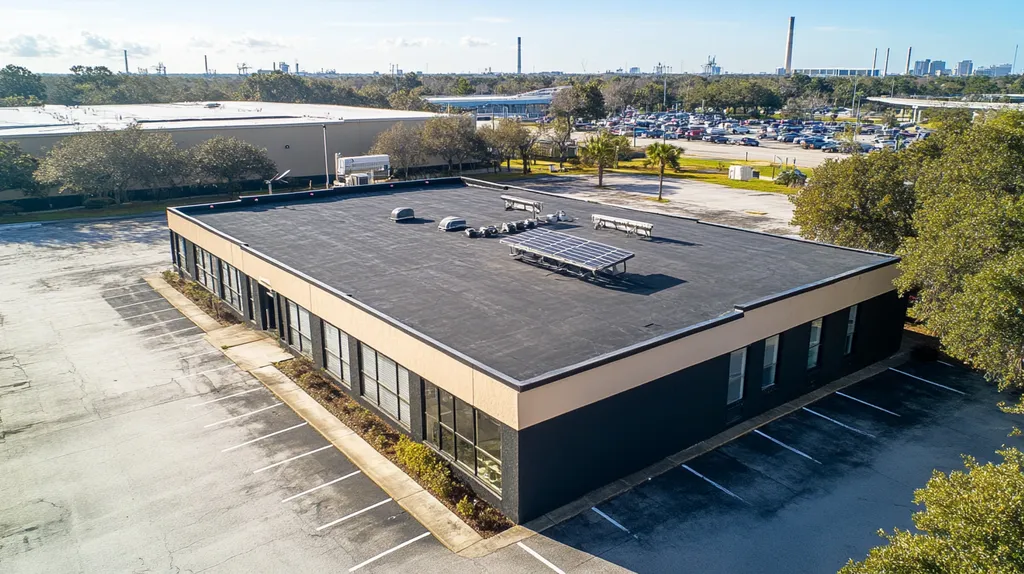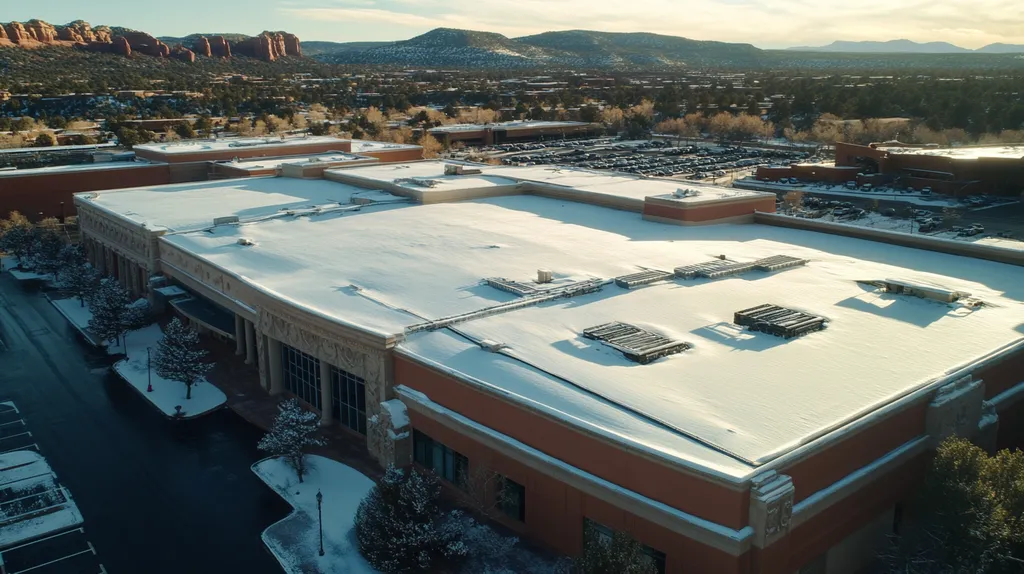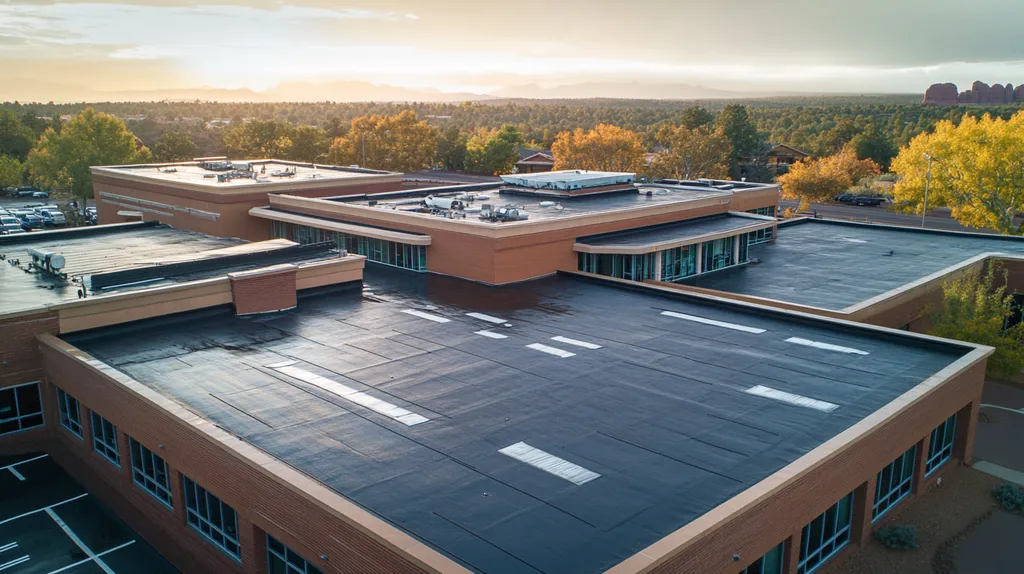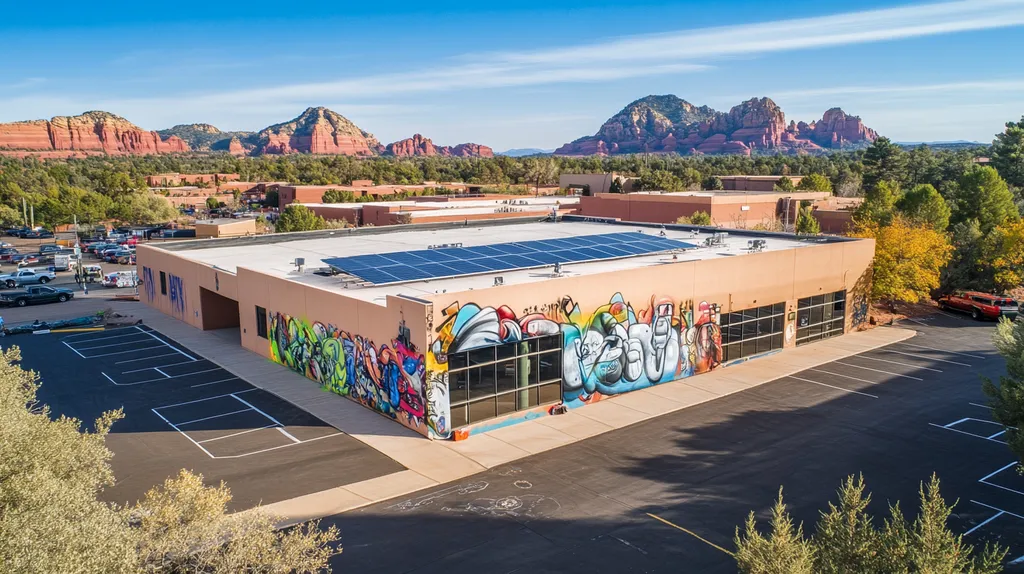Commercial property owners lose an estimated $3.3 billion annually due to inefficient and poorly maintained roofs. With energy costs soaring 27% over the past three years, innovative repair solutions have become critical for protecting bottom lines.
From drone-enabled inspections to AI-powered maintenance scheduling, emerging technologies are revolutionizing how facilities managers approach roof repairs. These innovations can reduce repair costs by up to 40% while extending roof lifespans.
This comprehensive guide examines cost-cutting strategies across six key areas: performance metrics, financial planning, compliance, risk management, operations, and long-term sustainability.
SECTION 1: PERFORMANCE FACTORS
The condition of your commercial roof isn’t just about aesthetics; it plays a crucial role in your operational costs and overall sustainability. Did you know that up to 30% of a building’s energy can slip away through a poorly-maintained roof? Facility managers must prioritize energy efficiency, thermal integrity, and good insulation practices to keep expenses in check. By grasping these performance factors, decision-makers can implement strategies that lead to significant long-term savings and roof durability.
Energy Efficiency Metrics
Energy efficiency metrics serve as benchmarks to assess roofing effectiveness. A thoughtfully designed roof can drastically curb energy costs through reflective materials and quality insulation. For example, cool roofing technology can lower roof surface temperatures by over 50°F, slashing air conditioning expenses.
Facility managers should regularly analyze energy bills to discover inefficiencies, while thermal imaging can reveal hidden hot spots affecting energy use. Establishing clear energy efficiency benchmarks enables easier comparisons when selecting roofing materials.
Investing in energy-efficient roofing is not just smart; it’s financially rewarding. Higher energy ratings can unlock tax credits and rebates, making these upgrades even more attractive. By emphasizing energy efficiency, facility managers not only cut costs but also boost the property’s overall value.
Key Action Items
Thermal Integrity Assessment
Thermal integrity assessments measure a roof’s ability to prevent heat transfer, identifying insulation quality and air leaks that can inflate energy bills. An effective assessment can uncover hidden problems that might otherwise go unnoticed.
For instance, employing infrared thermography allows managers to quickly identify areas where insulation may be compromised—all without disrupting operations. This technology is essential in spotting thermal bridges that contribute to heat loss.
Regular thermal integrity assessments are vital to keeping roofs performing at their best. Proactive maintenance based on these assessments can lead to energy savings exceeding 20%. Emphasizing thermal integrity not only boosts comfort but also enhances efficiency, resulting in tangible financial benefits.
Key Action Items
Roof Insulation and Drainage
Effective roof insulation and drainage systems are essential for extending the life of a roof and preventing expensive repairs. Quality insulation regulates indoor temperatures, easing the burden on heating and cooling systems. Simultaneously, efficient drainage prevents water buildup, which can lead to leaks and structural issues.
Facility managers should ensure that insulation meets or exceeds local energy codes, as higher R-values can significantly improve energy performance. A roof without sufficient insulation can experience substantial heat loss, elevating energy costs and hastening deterioration.
In addition, a well-functioning drainage system plays a crucial role in preventing water pooling, which jeopardizes the roof’s structure. Regular maintenance of gutters and drains is essential to minimize sediment buildup and prolong roof life.
Key Action Items
SECTION 2: FINANCIAL CONSIDERATIONS
Delaying roof repairs can lead to skyrocketing expenses for commercial property owners. Neglecting regular maintenance might inflate repair costs by as much as 30%. For facility managers, understanding financial strategies to keep these costs manageable is crucial. This section will explore the cost-benefit analysis of maintenance, the return on investment for proactive measures, and smart budgeting tips for roof repairs and replacements.
Cost-Benefit Analysis of Maintenance
Conducting a cost-benefit analysis of routine maintenance can unveil impressive advantages. Regular inspections paired with minor repairs can prevent costly disasters from developing. For instance, nipping a small leak in the bud can save thousands in potential water damage.
Facility managers need to weigh the long-term savings from preventive maintenance. By investing in small repairs now, they can extend the lifespan of the roof, ultimately minimizing the need for a full replacement later. This strategic approach not only helps manage expenses but also fortifies the overall integrity of the building.
Moreover, many roof systems come with warranties that stipulate regular maintenance must be documented. Failing to fulfill these requirements can void warranties, leading to unexpected financial woes. By recognizing these financial stakes, facility managers can foster a culture of proactive maintenance.
Key Action Items
ROI on Preventive Maintenance
Understanding the return on investment (ROI) for preventive maintenance is key to justifying expenses. Research shows that each dollar spent on preventive maintenance can generate up to $4 in savings on emergency repairs—a compelling reason to embrace a proactive approach.
This type of maintenance not only cuts down on repair frequency but also boosts energy efficiency. A well-cared-for roof mitigates leaks that might spike heating and cooling bills. Although the initial costs for maintenance may appear steep, the long-term savings can far surpass those investments.
Additionally, robust roof performance can enhance property value. By investing in maintenance, property managers create a more dependable facility that appeals to tenants and potential buyers. Thus, the ROI extends beyond mere finances; it amplifies the overall property value too.
Key Action Items
Budgeting for Roof Repairs and Replacement
Strategic budgeting for roof repairs and replacements is vital for maintaining financial stability. Facility managers should create a dedicated reserve fund using historical data and lifespans of roofing materials. This foresight helps shield the budget from sudden financial shocks when major repairs arise.
Detailed forecasting is also essential. By analyzing the age and condition of roofs, managers can estimate when replacements will be necessary. This method allows for planned expenses rather than reactive spending that can burden finances.
Leveraging technology can simplify the budgeting process. Using roofing management software helps track maintenance schedules, pinpoint upcoming repairs, and monitor costs effectively. This ensures facilities remain financially prepared while making informed decisions about roofing needs.
Key Action Items
SECTION 3: COMPLIANCE REQUIREMENTS
Staying compliant with roofing regulations is not merely a legal obligation; it can have a profound impact on repair costs and the sustainability of your building. Ignoring these standards can lead to hefty fines, frustrating project delays, and even disputes with insurers. Facility managers must navigate the intricate world of regulations—including building codes, environmental requirements, and safety measures—to make informed decisions that keep costs down while remaining compliant. This section uncovers vital compliance considerations that property owners need to factor into their roofing strategies.
Regulatory Standards for Roofing
Regulatory standards establish guidelines for the materials, techniques, and safety practices in commercial roofing. For instance, the International Building Code (IBC) lays out essential criteria to ensure roof systems are safe and functional. It’s crucial for facility managers to be aware of local regulations that may vary and often reflect specific climate and environmental needs.
A significant aspect of these regulations is fire safety. In some regions, the use of fire-resistant materials is a must, which can directly affect material costs. Knowing these requirements from the outset can save money and prevent the need for costly retrofits later.
Embracing innovative technologies, such as drone-assisted roof inspections, can simplify compliance checks. These cutting-edge tools not only help maintain standards but also allow for early identification of repairs, which can lower overall costs and repair time.
Key Action Items
Building Code Compliance Checks
Building codes outline the minimum standards required for construction and renovations, including roofing systems. Conducting a thorough compliance check before any roof repair is essential. This often involves licensed inspectors familiar with both local and national codes to ensure all work aligns with the appropriate standards.
Non-compliance can lead to expensive fines and delays. Issues such as incorrect materials or installation methods could necessitate rework, inflating costs significantly. Facility managers should conduct routine compliance assessments, ideally before initiating repairs, to avoid these pitfalls.
Taking a proactive approach to building code compliance can unveil cost-saving opportunities. Some regions offer incentives for energy-efficient roofing solutions, which can offset overall repair expenditures. Identifying these potential savings can benefit the facility financially.
Key Action Items
Environmental Impact Regulations
The shift toward sustainability means environmental regulations are now a key factor in commercial roofing decisions. Standards like the U.S. Green Building Council’s LEED certification encourage sustainable practices in construction and upkeep. Compliance can lead to substantial long-term savings and enhance a property’s appeal.
Adopting practices such as using eco-friendly materials and adhering to waste disposal regulations is essential. Properly disposing of roofing materials not only satisfies legal obligations but also helps avoid costly fines tied to environmental breaches.
Facility managers should also explore the advantages of installing green roofs or cool roofing systems. These options can enhance energy efficiency, reduce utility bills, and even qualify for tax breaks, providing financial incentives alongside environmental benefits.
Key Action Items
SECTION 4: RISK MANAGEMENT
Commercial roof repairs can feel overwhelming, especially when leaks pop up unannounced. Did you know that water intrusion is responsible for around 30% of a building’s damage? This not only leads to costly repairs but can also result in serious structural issues. To safeguard investments and maintain operational continuity, identifying potential risks is vital. In this section, we’ll delve into pinpointing leak sources, evaluating structural integrity, and developing effective emergency repair plans.
Identifying Potential Leak Sources
Recognizing possible leak areas is fundamental to smart risk management. Flashing failures, seam separations, and roof penetrations like vent pipes and HVAC units are common trouble spots. By performing regular visual inspections, facility managers can catch these vulnerabilities before they escalate into expensive repairs.
Utilizing infrared technology helps detect moisture that’s trapped under roofing membranes, allowing for targeted repairs rather than costly complete overhauls. Implementing a routine inspection schedule not only aids in early detection but significantly prolongs the roof’s lifespan.
Familiarizing staff with various roofing materials can enhance their ability to spot potential leak sources. For example, membrane roofs may face frequent issues depending on their exposure. Regular training sessions are essential for maintenance staff to recognize signs of deterioration promptly.
Key Action Items
Assessing Structural Integrity Risks
The structural integrity of a roof is vital for ensuring its longevity and performance. Flat roofs, for instance, are particularly susceptible to water pooling, which can jeopardize overall stability. Property owners should prioritize regular load assessments, especially following severe weather events.
Staying compliant with building codes is key since these regulations ensure rooftops can withstand environmental stresses. Facilities managers must keep up with local code updates that might affect roofing structures.
Professional inspections bring valuable insights into structural health. Engaging certified roofing contractors can uncover risks that might go unnoticed during routine checks, leading to early intervention for hidden threats.
Key Action Items
Emergency Repair Contingency Plans
No facility manager has a crystal ball for roofing emergencies, making contingency plans essential. A robust emergency repair plan can significantly cut down on downtime and curb damage from unforeseen events like heavy rainfall or hailstorms.
Compile a contact list for reliable roofing contractors to ensure swift responses. Nurturing relationships with multiple vendors provides backup options and prevents repair delays when disasters strike.
Running emergency drills can prepare staff for their roles during a roofing crisis. These preparedness exercises should outline steps for protecting equipment and minimizing product loss following sudden leaks.
Key Action Items
SECTION 5: OPERATIONAL PROCEDURES
In the bustling arena of commercial real estate, prioritizing roof maintenance stands as a shield against expensive setbacks. The National Roofing Contractors Association reveals that a staggering 80% of roof replacements are due to neglect rather than actual material failure. By establishing structured operational procedures, facility managers can significantly cut long-term repair expenses while maximizing the lifespan of their roofs. This section unveils vital tactics like maintenance schedules, cutting-edge inspection technologies, and preventative protocols to keep roofs in peak condition.
Scheduled Maintenance Schedules
Creating a systematic maintenance schedule is essential for every commercial roofing system. Regular maintenance should occur at least twice a year, targeting seasonal preparations to avert weather-related damage. For example, conducting roof inspections before winter helps prevent ice dams and potential leaks.
This proactive approach allows for the early identification of minor issues before they blossom into major headaches. Research indicates that consistent inspections can slash repair costs by an impressive 30%. Facilities managers are encouraged to document findings meticulously to inform future maintenance planning.
To streamline the process, consider using a calendar system that sends reminders for inspections and regular upkeep. Employing a contractor who specializes in the specific roofing type can enhance evaluations tailored to unique building structures.
Key Action Items
Innovative Inspection Technologies
Leveraging innovative inspection technologies can revolutionize roof assessment processes. Drones outfitted with high-resolution cameras offer aerial views of roofs, conducting thorough inspections without the risks associated with traditional methods.
Additionally, thermal imaging technology has emerged as a vital tool. It effectively identifies moisture trapped beneath roofing layers, which can cause substantial damage if undetected. Early detection with these devices can lead to significant savings in repair costs.
Utilizing building information modeling (BIM) software helps track roof conditions over time. Integrating data from inspections allows facilities managers to make educated decisions about necessary maintenance and budget allocations.
Key Action Items
Preventative Maintenance Protocols
Implementing effective preventative maintenance protocols is key to minimizing the need for major repairs. Facilities managers should develop a checklist encompassing tasks such as clearing debris, inspecting seams, and ensuring that drainage systems function properly.
Regular cleaning of gutters and roof surfaces helps prevent water from pooling, a leading cause of leaks. A proactive maintenance approach can save businesses as much as 20% in repair costs, according to the Small Business Administration.
Moreover, empowering staff with training on basic roof care techniques fosters an environment focused on prevention. This initiative not only reinforces roof upkeep but also cultivates a maintenance-first culture across facility teams.
Key Action Items
SECTION 5: OPERATIONAL PROCEDURES
In the fast-paced world of commercial real estate, overlooking roof maintenance can lead to significant financial setbacks. The National Roofing Contractors Association highlights that an astonishing 80% of roof replacements are driven by neglect rather than actual material failure. By introducing structured operational procedures, facility managers can dramatically lower long-term repair costs while extending the lifespan of their roofs. This section reveals essential strategies, including maintenance schedules, cutting-edge inspection technologies, and preventative protocols to ensure roofs remain in peak condition.
Scheduled Maintenance Schedules
Establishing a regular maintenance schedule is critical for every commercial roofing system. Maintenance should occur at least biannually, focusing on seasonal preparations to prevent weather-related damage. For example, inspecting roofs before winter can avoid ice dams and unwanted water intrusion.
This proactive approach allows for the detection of minor issues before they develop into significant headaches. Research shows that regular inspections can slash repair costs by up to 30%. Facilities managers should meticulously document findings and track repairs for informed future planning.
Using a calendar system can streamline this process, sending timely reminders for inspections and routine upkeep. Partnering with a contractor who specializes in the specific roofing type can enhance evaluations tailored to unique building structures.
Key Action Items
Innovative Inspection Technologies
Leveraging innovative inspection technologies can revolutionize roof assessments. Drones equipped with high-resolution cameras enable aerial inspections, providing comprehensive views of the roof without the hazards associated with traditional methods.
Thermal imaging technology is another game changer. It detects moisture trapped beneath roofing materials, which can lead to substantial damage if undetected. Early detection using these technologies can save thousands in potential repairs.
Additionally, building information modeling (BIM) software can help track roof conditions over time. By integrating data from inspections, facilities managers can make informed decisions about maintenance and budget allocations.
Key Action Items
Preventative Maintenance Protocols
Implementing effective preventative maintenance protocols is essential for minimizing the need for major repairs. Facilities managers should create a checklist that includes tasks such as clearing debris, inspecting seams, and ensuring that drainage systems function properly.
Regular cleaning of gutters and roof surfaces helps halt water accumulation, a leading cause of leaks. According to the Small Business Administration, this proactive approach can save up to 20% on repair costs.
Additionally, equipping staff with training on basic roof care techniques empowers them to tackle minor issues as they arise. This practical step fosters a culture of prevention and reinforces the significance of consistent roof maintenance across facility teams.
Key Action Items
The Bottom Line
Commercial roofing innovations have dramatically shifted the repair cost landscape, with AI-enabled maintenance reducing expenses by up to 40% and extending roof lifespans by 15-20 years.
From drone inspections to thermal imaging technology, these advancements are revolutionizing how facility managers approach roof maintenance and repairs.
The data is clear: properties implementing preventative maintenance protocols and leveraging new inspection technologies see a 30% reduction in emergency repairs and save an average of $2.50 per square foot annually in energy costs.
As roofing technology continues evolving, staying informed about these innovations isn’t just about cost savings – it’s about protecting your property’s most critical asset while ensuring operational continuity and regulatory compliance.
FREQUENTLY ASKED QUESTIONS
Q. How does energy efficiency affect my commercial roof?
A. Energy efficiency plays a key role in reducing operational costs. A well-maintained roof significantly decreases energy loss, leading to lower utility bills. Regular checks and proper insulation help keep your commercial roof performing efficiently.
Q. What financial strategies can help with industrial roof repairs?
A. Conduct regular maintenance to mitigate repair costs. Understanding the return on investments for preventive measures can be crucial. Solid budgeting and planning improve your approach to managing industrial roof issues efficiently.
Q. What are key compliance requirements for a commercial roof?
A. Compliance with local and national regulations is essential. Ensuring adherence to building codes and safety standards prevents hefty fines and enhances roof longevity. Regular reviews and updates on regulations keep your roof compliant and functional.
Q. How can I manage risks related to my industrial roof?
A. Identifying potential leak sources is vital for effective risk management. Conducting regular inspections and using advanced technologies helps recognize vulnerabilities early. These proactive measures can prevent costly damages and maintain stability.
Q. Why are operational procedures important for roof maintenance?
A. Structured procedures prevent neglect, which is the main cause of roof issues. By implementing regular maintenance schedules and leveraging innovative technologies, facility managers can extend roof lifespan and reduce overall repair costs.
Q. What innovative technologies can enhance roof inspections?
A. Advanced inspection technologies like drones and thermal imaging provide comprehensive, safer evaluations. These tools help identify maintenance needs early, promote proactive repairs, and ultimately save on extensive repair costs.
Q. How can I prepare for unexpected roof emergencies?
A. Developing an emergency repair plan is essential. Compile a list of reliable contractors, conduct drills, and ensure all staff understand their roles in case of an unexpected roofing incident. This preparedness helps minimize damage and downtime.










